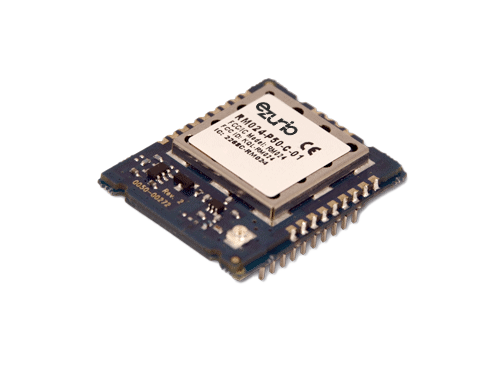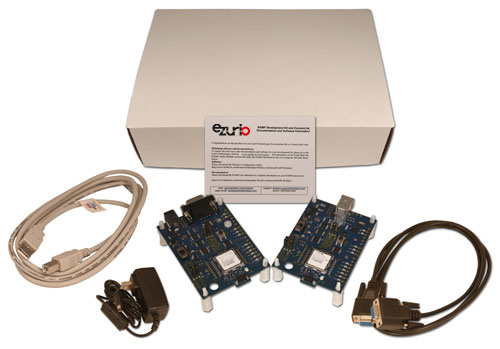RM024 Series

Overview
The RM024 RAMP module is based on Laird's LT2510 core technology, enhanced with a new RF front end for improved sleep, improved link budget and a switchable antenna output. With its field-proven FHSS air interface protocol, the RM024 rejects RF noise, excels in multipath scenarios, allows for co-located systems, and provides an extremely reliable communication link. It also provides a more robust, but simpler, link than ZigBee for RF applications that do not require a mesh topology.
Note: Some variants of the RM024 and related DVK and SDK variants have reached end of production and are available on a limited basis only. Please review the June 2019 End of Life Announcement.
- RM024-S125-C-30 - Mass Production
- RM024-P125-C-30- Mass Production
- RM024-S10-C-30 – Mass Production
- RM024-P10-C-30 - Mass Production
- RM024-S125-M-30 – * June 2019 - Reference EOL notice
- RM024-P125-M-30– * June 2019 - Reference EOL notice
- RM024-S10-M-30– * June 2019 - Reference EOL notice
- RM024-P10-M-30– * June 2019 - Reference EOL notice
Buy Now
Specifications
Part Number
| Price @ 1k
| Antenna Options
| Antenna Type
| Channels
| Chipset (Wireless)
| Compliance
| Connector
| Data Rate
| Dimension (Height - mm)
| Dimension (Length - mm)
| Dimension (Width - mm)
| Frequency Range (Max)
| Frequency Range (Min)
| Input Power
| Logical Interfaces
| Network Architecture
| OS/Software
| Output Power
| Power Consumption (Rx)
| Power Consumption (Tx)
| Product Type
| Protocols
| Range
| Receive Sensitivity
| Security
| Software
| System Architecture
| Technology
| Transmit Power (Max)
| Wireless Specification
|
|---|---|---|---|---|---|---|---|---|---|---|---|---|---|---|---|---|---|---|---|---|---|---|---|---|---|---|---|---|---|---|
| N/A | U.FL Jack | External | 42 selectable channels | TI CC2510 | CE | SMT | 280 kbps or 500 kbps selectable | 3.6 mm | 32.4 mm | 25.4 mm | 2483 MHz | 2402 MHz | 2.3 - 3.6 V - 50 mV ripple | UART | server/client | Configuration and Test Software | 10 mW | 36 mA | 40 mA | Embedded Module | FHSS Wireless Protocol | Outdoor: 0.6 miles(1.0km). Indoor: 328 ft(100m) | -95 dBm at 280 kbps RF Data Rate | Channelization | Laird Configuration Utility | Hosted | Proprietary RF (2.4 GHz) | +3.5 to +10 dBm | 2.4 GHz FHSS | |
| N/A | U.FL Jack | External | 42 or 78 selectable channels | TI CC2510 | FCC/IC | Pluggable | 280 kbps or 500 kbps selectable | 10.6 mm | 33 mm | 26.7 mm | 2483 MHz | 2402 MHz | 2.3 - 3.6 V - 50 mV ripple | UART | server/client | Configuration and Test Software | 125 mW | 36 mA | 136 mA | Embedded Module | FHSS Wireless Protocol | Outdoor: 2.5 miles(4km). Indoor: 1300 ft(400m) | -95 dBm at 280 kbps RF Data Rate | Channelization | Laird Configuration Utility | Hosted | Proprietary RF (2.4 GHz) | +5 to +21 dBm selectable | 2.4 GHz FHSS | |
| N/A | U.FL Jack | External | 42 selectable channels | TI CC2510 | CE | SMT | 280 kbps or 500 kbps selectable | 3.6 mm | 32.4 mm | 25.4 mm | 2483 MHz | 2402 MHz | 2.3 - 3.6 V - 50 mV ripple | UART | server/client | Configuration and Test Software | 10 mW | 36 mA | 40 mA | Embedded Module | FHSS Wireless Protocol | Outdoor: 0.6 miles(1.0km). Indoor: 328 ft(100m) | -95 dBm at 280 kbps RF Data Rate | Channelization | Laird Configuration Utility | Hosted | Proprietary RF (2.4 GHz) | +3.5 to +10 dBm | 2.4 GHz FHSS | |
| N/A | U.FL Jack | External | TI CC2510 | FCC/IC | SMT | 280 kbps or 500 kbps selectable | 3.6 mm | 32.4 mm | 25.4 mm | 2483 MHz | 2402 MHz | 2.3 - 3.6 V - 50 mV ripple | UART | server/client | Configuration and Test Software | 125 mW | 36 mA | 136 mA | Embedded Module | FHSS Wireless Protocol | Outdoor: 2.5 miles(4km). Indoor: 1300 ft(400m) | Laird Configuration Utility | Hosted | Proprietary RF (2.4 GHz) | 2.4 GHz FHSS | |||||
| N/A | U.FL or Chip | External | 42 selectable channels | TI CC2510 | CE | Pluggable | 280 kbps or 500 kbps selectable | 11.3 mm | 39.6 mm | 26.7 mm | 2483 MHz | 2402 MHz | 2.3 - 3.6 V - 50 mV ripple | UART | server/client | Configuration and Test Software | 10 mW | 36 mA | 40 mA | Embedded Module | FHSS Wireless Protocol | Outdoor: 0.6 miles(1.0km). Indoor: 328 ft(100m) | -95 dBm at 280 kbps RF Data Rate | Channelization | Laird Configuration Utility | Hosted | Proprietary RF (2.4 GHz) | +3.5 to +10 dBm | 2.4 GHz FHSS | |
| N/A | U.FL or Chip | External | 42 or 78 selectable channels | TI CC2510 | FCC/IC | Pluggable | 280 kbps or 500 kbps selectable | 11.3 mm | 39.6 mm | 26.7 mm | 2483 MHz | 2402 MHz | 2.3 - 3.6 V - 50 mV ripple | UART | server/client | Configuration and Test Software | 125 mW | 36 mA | 136 mA | Embedded Module | FHSS Wireless Protocol | Outdoor: 2.5 miles(4km). Indoor: 1300 ft(400m) | -95 dBm at 280 kbps RF Data Rate | Channelization | Laird Configuration Utility | Hosted | Proprietary RF (2.4 GHz) | +5 to +21 dBm selectable | 2.4 GHz FHSS | |
| N/A | U.FL or Chip | External | 42 selectable channels | TI CC2510 | CE | SMT | 280 kbps or 500 kbps selectable | 3.6 mm | 39 mm | 25.4 mm | 2483 MHz | 2402 MHz | 2.3 - 3.6 V - 50 mV ripple | UART | server/client | Configuration and Test Software | 10 mW | 36 mA | 40 mA | Embedded Module | FHSS Wireless Protocol | Outdoor: 0.6 miles(1.0km). Indoor: 328 ft(100m) | -95 dBm at 280 kbps RF Data Rate | Channelization | Laird Configuration Utility | Hosted | Proprietary RF (2.4 GHz) | +3.5 to +10 dBm | 2.4 GHz FHSS | |
| N/A | U.FL or Chip | External | 42 or 78 selectable channels | TI CC2510 | FCC/IC | SMT | 280 kbps or 500 kbps selectable | 3.6 mm | 39 mm | 25.4 mm | 2483 MHz | 2402 MHz | 2.3 - 3.6 V - 50 mV ripple | UART | server/client | Configuration and Test Software | 125 mW | 36 mA | 136 mA | Embedded Module | FHSS Wireless Protocol | Outdoor: 2.5 miles(4km). Indoor: 1300 ft(400m) | -95 dBm at 280 kbps RF Data Rate | Channelization | Laird Configuration Utility | Hosted | Proprietary RF (2.4 GHz) | +5 to +21 dBm selectable | 2.4 GHz FHSS |
Documentation
Product Brief 1 total
Name |
Part |
Last Updated |
|---|---|---|
| Product Brief - RM024 | All | 10/13/2021 |
Datasheet 1 total
Name |
Part |
Last Updated |
|---|---|---|
| Datasheet - RM024 | All | 09/26/2022 |
Application Note 5 total
Name |
Part |
Last Updated |
|---|---|---|
| Application Note - Cyclic Sleep Modes | All | 03/01/2019 |
| Application Note - Enabling the Security Pane in the RAMP Configuration Utility | All | 07/31/2024 |
| Application Note - Repeater Set-up | All | 08/01/2024 |
| Application Note - RM024 Part Numbers and Firmware | All | 03/01/2019 |
| Application Note - Updating USB Serial Drivers for RAMP Products | All | 07/23/2024 |
Software 7 total
Name |
Part |
Last Updated |
|---|---|---|
| Configuration and Test Utility Software v6.07 | All | 07/23/2024 |
| RM024 v2.5-0.zip | All | 01/17/2019 |
| RM024 v2.9-0.zip | All | 01/17/2019 |
| RM024 v3.1-0.zip | All | 03/01/2019 |
| RM024-C-LIBRARY v1 0-0.zip | All | 01/17/2019 |
| RM024-Sxxx-C-xx.zip | All | 01/17/2019 |
| RM v2.3-0.zip | All | 01/17/2019 |
Documentation 9 total
Name |
Part |
Last Updated |
|---|---|---|
| Configuration and Test Utility Software - RAMP Modules | All | 07/22/2024 |
| EOL - RAMP - June-10-2019 | All | 02/10/2022 |
| EOL - RAMP - Nov-15-2015 | All | 03/01/2019 |
| PCN 9E-2021 - RM024 Series | All | 10/04/2021 |
| PCN #2D-2025 - RM024 rebrand Ezurio | All | 03/06/2025 |
| Release Notes - RM024 Firmware v2.9-0 and previous | All | 06/04/2019 |
| RM024 Release Notes - version 3.1-0 | All | 06/04/2019 |
| User Guide - RM024 Series | All | 11/03/2022 |
| User Manual - RM024 DVK | All | 03/01/2019 |
Certification 11 total
Name |
Part |
Last Updated |
|---|---|---|
| AS/NZS Certifications - RM024 | All | 11/20/2020 |
| EU Certifications - RM024 | All | 01/26/2024 |
| FCC Certifications - RM024 | All | 12/15/2020 |
| ISED Certifications - RM024 | All | 12/15/2020 |
| ISED ICES-003 Issue 7 Declaration of Compliance | All | 05/18/2021 |
| KC Certifications - RM024 | All | 12/15/2020 |
| MIC Certifications - RM024 | All | 12/15/2020 |
| NCC Certifications - RM024 | All | 11/20/2020 |
| Regulatory Information - RM024 | All | 01/26/2024 |
| RoHS 3 - Bluetooth | All | 03/06/2025 |
| RoHS 3 - RAMP ISM Modules | All | 03/06/2025 |
Become an Ezurio Customer to Gain Exclusive Access to Our Design Experts
- Antenna Scans
- Antenna selection and placement
- Custom antenna design
- Worldwide EMC testing / certifications
- Embedded RF hardware / firmware design
- Cloud architecture and integration
- Mobile application development
- Product & Industrial Design
Distributors
| Distributor | Phone Number | Region | Website |
|---|---|---|---|
| Arrow Electronics | 1-855-326-4757 +44 2039 365486 |
APAC, North America, South America, EMEA | Website |
| Braemac Australia, New Zealand, South East Asia | +61 2 9550 6600 +64 9 477 2148 |
APAC | Website |
| DigiKey | 1-800-344-4539 |
North America, South America, APAC, EMEA | Website |
| EBV Elektronik | EMEA | Website | |
| Farlink Technology China, Hong Kong | +86 13266922199 |
APAC | Website |
| Farnell | 1-800-936-198 +44 3447 11 11 22 |
EMEA | Website |
| Future Electronics | 1-800-675-1619 1-514-428-8470 |
North America, South America, APAC, EMEA | Website |
| Glyn | +49-6126-590-0 |
EMEA | Website |
| Hy-Line Germany Only | +49 89 614 503 0 |
EMEA | Website |
| Jetronic China, Hong Kong and Taiwan | 852-27636806 |
APAC | Website |
| M2M Germany | +49-6081-587386-0 |
EMEA | Website |
| Martinsson | +46 8 7440300 |
EMEA | Website |
| McCoy South East Asia | +65 6515 2988 |
APAC | Website |
| Mouser Electronics | 1-800-346-6873 +44 1494 427500 |
North America, South America, APAC, EMEA | Website |
| RS Components | +852-2421-9898 +44 3457-201201 |
North America, South America, APAC, EMEA | Website |
| Ryoyo Japan | +81-3-3543-7711 |
APAC | Website |
| Solsta UK Only | +44 (0) 1527 830800 |
EMEA | Website |
| Supreme Components International India, South East Asia | +65 6848-1178 |
APAC | Website |
| Symmetry Electronics | 1-866-506-8829 |
North America | Website |
| Tekdis Australia and New Zealand | +61 3 8669 1210 |
APAC | Website |
| Telsys | +972 3 7657666 |
EMEA | Website |
| WPG | +44 1628 958460 |
EMEA | Website |
 Laird Connectivity is now Ezurio
Laird Connectivity is now Ezurio



/filters:background_color(white)/2024-10/DVK-RM024.jpg)